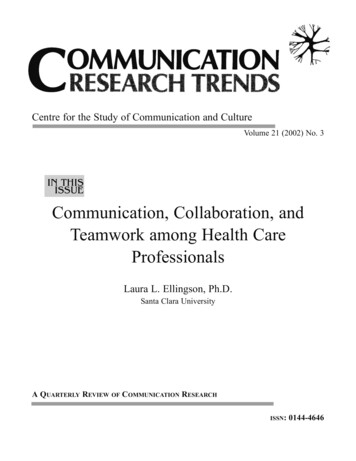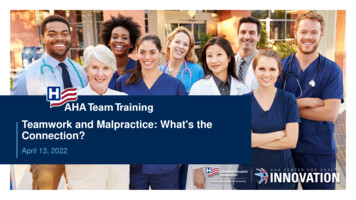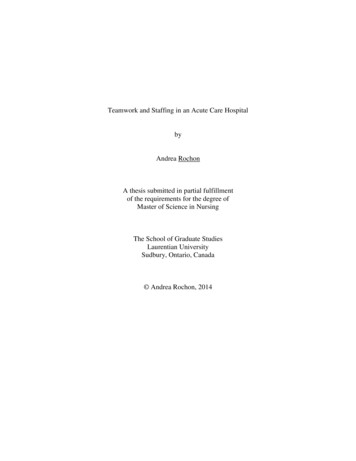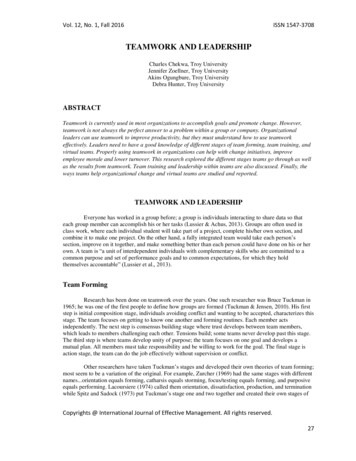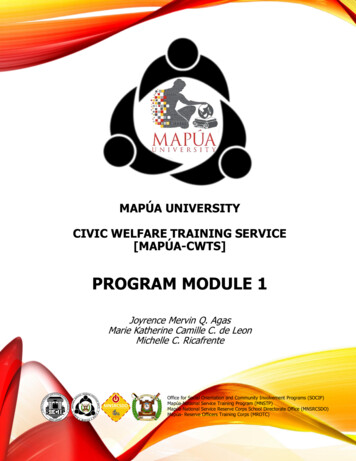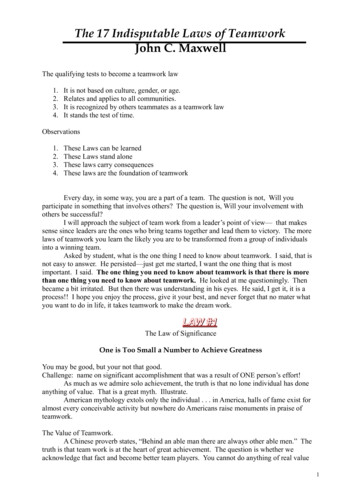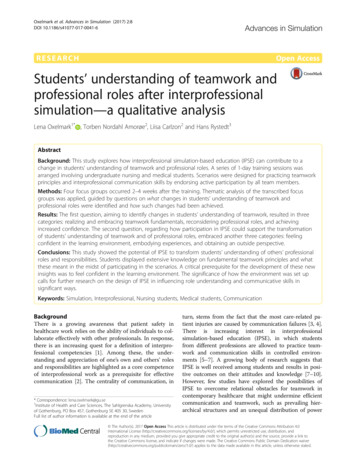
Transcription
Oxelmark et al. Advances in Simulation (2017) 2:8DOI 10.1186/s41077-017-0041-6RESEARCHOpen AccessStudents’ understanding of teamwork andprofessional roles after interprofessionalsimulation—a qualitative analysisLena Oxelmark1* , Torben Nordahl Amorøe2, Liisa Carlzon2 and Hans Rystedt3AbstractBackground: This study explores how interprofessional simulation-based education (IPSE) can contribute to achange in students’ understanding of teamwork and professional roles. A series of 1-day training sessions wasarranged involving undergraduate nursing and medical students. Scenarios were designed for practicing teamworkprinciples and interprofessional communication skills by endorsing active participation by all team members.Methods: Four focus groups occurred 2–4 weeks after the training. Thematic analysis of the transcribed focusgroups was applied, guided by questions on what changes in students’ understanding of teamwork andprofessional roles were identified and how such changes had been achieved.Results: The first question, aiming to identify changes in students’ understanding of teamwork, resulted in threecategories: realizing and embracing teamwork fundamentals, reconsidering professional roles, and achievingincreased confidence. The second question, regarding how participation in IPSE could support the transformationof students’ understanding of teamwork and of professional roles, embraced another three categories: feelingconfident in the learning environment, embodying experiences, and obtaining an outside perspective.Conclusions: This study showed the potential of IPSE to transform students’ understanding of others’ professionalroles and responsibilities. Students displayed extensive knowledge on fundamental teamwork principles and whatthese meant in the midst of participating in the scenarios. A critical prerequisite for the development of these newinsights was to feel confident in the learning environment. The significance of how the environment was set upcalls for further research on the design of IPSE in influencing role understanding and communicative skills insignificant ways.Keywords: Simulation, Interprofessional, Nursing students, Medical students, CommunicationBackgroundThere is a growing awareness that patient safety inhealthcare work relies on the ability of individuals to collaborate effectively with other professionals. In response,there is an increasing quest for a definition of interprofessional competencies [1]. Among these, the understanding and appreciation of one’s own and others’ rolesand responsibilities are highlighted as a core competenceof interprofessional work as a prerequisite for effectivecommunication [2]. The centrality of communication, in* Correspondence: lena.oxelmark@gu.se1Institute of Health and Care Sciences, The Sahlgrenska Academy, Universityof Gothenburg, PO Box 457, Gothenburg SE 405 30, SwedenFull list of author information is available at the end of the articleturn, stems from the fact that the most care-related patient injuries are caused by communication failures [3, 4].There is increasing interest in interprofessionalsimulation-based education (IPSE), in which studentsfrom different professions are allowed to practice teamwork and communication skills in controlled environments [5–7]. A growing body of research suggests thatIPSE is well received among students and results in positive outcomes on their attitudes and knowledge [7–10].However, few studies have explored the possibilities ofIPSE to overcome relational obstacles for teamwork incontemporary healthcare that might undermine efficientcommunication and teamwork, such as prevailing hierarchical structures and an unequal distribution of power The Author(s). 2017 Open Access This article is distributed under the terms of the Creative Commons Attribution 4.0International License (http://creativecommons.org/licenses/by/4.0/), which permits unrestricted use, distribution, andreproduction in any medium, provided you give appropriate credit to the original author(s) and the source, provide a link tothe Creative Commons license, and indicate if changes were made. The Creative Commons Public Domain Dedication o/1.0/) applies to the data made available in this article, unless otherwise stated.
Oxelmark et al. Advances in Simulation (2017) 2:8relationships [11]. The need to address these aspects isunderlined by research indicating that nursing and medical students’ understanding of professional roles is mainlytraditional and tends to be stereotypical [12, 13]. Establishing a level of trust has been noted as necessary forpromoting open communication and reflection insimulation-based training [14, 15]. Further, trust has beenidentified as central for effective interprofessional collaboration and the need for introducing trust-building activities through interprofessional education [15, 16].Background for the present study was the course evaluations from 172 participants (128 nursing and 44 medical students), including 29 teams in all, showing thatthe interprofessional simulation sessions were highly appreciated. Almost all students stated that the trainingimproved their communicative skills (97%) and ability tohandle patients’ health problems (89%). The studentsrated highly what they had learned about their own andothers’ professions (92 and 95%, respectively) and almostunanimously (99%) would recommend other students totake part in this training. While the results from theevaluations clearly indicated that the students found thetraining beneficial, it motivated a further study to gainmore specific knowledge on what the students learnedin terms of interprofessional teamwork and the possibilities and constraints of IPSE to contribute suchoutcomes.Although interprofessional training seems to be aviable option to cause a change in student attitudes,recent studies point out communication barriers between professions as obstacles for interprofessionalteamwork [17] which can also hinder the establishment of trusting relations through IPSE [18–20]. Aaseet al. [18] investigated the views of students, educators, and healthcare staff on how to design interprofessional training. Although their views were mainlypositive, they also expressed that unequal power relationships between nurses and physicians could hamper successful outcomes of training [18]. Anotherstudy investigating nursing and medical students’ participation in IPSE showed that hierarchies within theteam as well as the lack of cross-disciplinary knowledge seemed to constrain the participants’ predisposition to speak freely and to share responsibility [19].The present study investigates these concerns in aqualitative analysis of focus group data with undergraduate nursing and medical students after participating inIPSE. Specifically, this study aims to understand if andhow IPSE can change students’ perception of eachother’s professions and their understanding of teamworkprinciples. A further and related aim was to identifywhat features of the IPSE design have potential forbringing about such changes. The empirical analysis wasdriven by two research questions:Page 2 of 8 What changes in students’ understanding ofteamwork and professional roles can be identifiedthrough IPSE? How can IPSE support the transformation ofstudents’ understanding of teamwork and ofprofessional roles?MethodsResearch design and settingThe interprofessional training program involved nursing students during their last semester of a 3-yeareducation and medical students during the final yearsof their five-and-a-half-year education (semesters 8–11). The objective for the 1-day training was tostrengthen the competencies needed for a collaborative management of emergency situations.A lecture preceded the training to emphasize the principles of teamwork, structured communication, and systematic management of patients in everyday butpotentially life-threatening situations. To clarify and outline the focus of the training, four goals were emphasized from Crisis Resource Management (CRM) andAdvanced Trauma Life Support (ATLS) principles. Theexplicit goals were to train (1) structured examinationthrough ABCDE (Airway, Breathing, Circulation, Disability, Environment) and (2) structured communicationthrough SBAR (Situation, Background, Assessment, Recommendation) and to give (3) feedback by applyingclosed loop communication and (4) attention to criticaloccurrences through “Speak up” [20–23]. Five scenarioswere designed with these objectives directly relating tointerprofessional collaboration (Additional file 1). Topromote active participation by the students from bothdisciplines, all scenarios included tasks that had to beperformed by each profession, both separately and incollaboration. The scenarios comprised common medical conditions (for example, confusion after postoperative bleeding, vasovagal reactions, breathing problems,and anaphylactic reactions) in various healthcare settingsthat the students are likely to meet in their early professional career. The training sessions utilized a three-stepmodel: briefing, scenario, and debriefing.Ten to 12 students participated in each and every dayof training. The large group was divided in two smallergroups of five to six students (comprising one to twomedical and four to five nursing students) that trainedin parallel. Every student participated in three to five ofthe five scenarios during the day and observed theothers. All students were introduced to the simulatorroom to become familiar with the environment and thesimulator used (SimMan 3G, Laerdal Medical, Stavanger,Norway). The active participants were introduced to thescenario they were about to encounter through a briefing. The observers followed the scenario on a projector
Oxelmark et al. Advances in Simulation (2017) 2:8screen in an adjacent room with instructions to observebehaviors (favorable and non-favorable) related to theobjectives. The debriefing followed the model developedby Steinwachs [24]: first, the participants were asked toexpress their immediate feeling (“vent”). This wasfollowed by a discussion that was divided into threesteps: (1) what went well during the scenario, (2) whatcould be improved, and (3) what could be learned fromthis scenario. The initial focus on favorable actions wasintended to establish a non-threatening situation and toserve as a basis for constructive discussion on whatcould be improved. Participants in the scenarios and observers were encouraged to engage in discussion andfeedback.Data collectionFocus groups were arranged to gain a deep understanding of responses to the research questions [25]. Thesewere carried out approximately 1–2 weeks after thetraining since a close proximity in time to the trainingwas preferred. To facilitate participation and avoid interfering with the usual study programs, the students attending the last two training days at the end of twosubsequent semesters were invited to participate, whichincluded 48 students. Twenty-three of these studentsvolunteered. Four focus groups were conducted, twowith nursing students (eight and six participants) andtwo with medical students (four and five students). Therationale for choosing uniprofessional groups was thatstudents were anticipated to express themselves morefreely with peers within their own discipline.A guide for the focus groups was developed (seeAdditional file 2). Each focus group was led by oneor two members of the research team (LC, LO, HR) andlasted for approximately 60 min. All focus groups wereaudio and video recorded and transcribed verbatim. Thevideo recordings were stored on a server in the universityand were revisited in cases of uncertainty on what wassaid and by whom in the interviews.Data analysisInductive thematic analysis was performed [26] with inspiration from Elo and Kyngäs [27]. The software NVivo[28] was used to organize and structure the data. Thetranscriptions were read by all authors several times inorder to become familiar with the data and gain a senseof the whole. The data corpus was openly coded byextracting meaning units corresponding to each of theresearch questions. Notes and headings were written inthe text while reading, and the text was read throughagain. This way, the headings portrayed all aspects of thecontent and developed the codes. The initial coding wasconducted by two of the researchers (HR and LO) collaborating. The codes were grouped into potentialPage 3 of 8themes to capture and describe recurrent phenomena.The themes were reviewed in relation to the coded extracts and the whole dataset to generate a thematic overview of the analysis. During the analysis, the themes wererefined in an iterative process until definitions and namesfor each theme were given. The themes formed the basisfor the presentation of the results together with a selectionof illustrative quotations, relating back to the analysis andresearch questions [26, 27]. To strengthen credibility, theanalysis was conducted independently by all authors andwas then discussed and modified by all authors until aconsensus and an agreement were reached [29].ResultsThe results are organized in accordance with the two research questions. The first section presents significantchanges in students’ understanding of teamwork andprofessional roles; the second section presents the conditions that were critical to enabling such transformations of understandings.Students’ understanding of teamwork and professionalrolesThree themes emerged from the analysis: (1) realizingand embracing teamwork fundamentals, (2) reconsidering professional roles, and (3) achieving increasedconfidence.Realizing and embracing teamwork fundamentalsA recurrent topic was the necessity of creating andmaintaining a shared view of the work process. The students expressed how the leader speaking out loud enabled them to prepare for the next step in the workprocess and invited all team members to suggest newideas in a joint problem-solving process. Another way ofmaintaining a shared view was to ask for clarifications.As one nursing student said:If you receive an instruction, I can say that I’m notreally sure how to proceed, it is really okay to ask.(Focus group 4)Further, the students emphasized that continuousfeedback enabled the leader of the team (most often inthe role of a physician) to maintain an overview, whichin turn, allowed other team members to focus on theirindividual tasks. One nursing student said:By giving feedback continuously, the physician gets thewhole picture, while I, if I have to set up a drip, I canjust focus on the drip for a while. Because then, I canlet the rest of the situation go for awhile, while thephysician has taken a step back and has an overview allthe time. (Focus group 4)
Oxelmark et al. Advances in Simulation (2017) 2:8Closely connected to the need to maintain an overviewwas the significance of leadership. Although the implication of keeping an open atmosphere and being reluctantto each others’ meanings, the students found that sharedresponsibility for the formation of leadership in the teamwas important and that the teamwork would be impaired and the structure of the team’s efforts ruinedwithout clear leadership. This was considered to be especially important in acute situations, and if someonedoes not take on this responsibility, it is important foroneself to take the leadership.The medical students expressed that a sense of trust inthe nurses’ competence was necessary for maintainingan overview. The fact that nursing students had the necessary knowledge to carry out specific tasks and thatthe medical students themselves did not, enabled themto maintain overall responsibility for the situation. Onemedical student stated:So if you just took it easy, then you realized that youcould just stand here and look, and get the overview.(Focus group 1)Page 4 of 8continuous adaptation to each other in the team. Onemedical student commented:Above all, I think I learnt really, really much aboutmyself, about strengths and weaknesses and aboveall how important it is to work with anotherprofessional group for the first time, because it isreally tight and you have to adjust your work in thesesituations. (Focus group 4)Another crucial experience was the importance of feeling free to cross each others’ professional boundariesand to remind each other of important measures thatotherwise might be forgotten (with potentially seriousconsequences for real patients) and that they wereallowed to do so. As one nursing student reported:You [referring to another nursing student] suggesteda drip and when we were discussing it afterwards,although it was to stepping into the doctor's territory,the doctor thought it was really positive that youcame up with a suggestion. (Focus group 4)Similarly, the nursing students found that the accomplishment of discrete tasks connected to their role presumed trust in the leader.The students expressed the importance of such transgressions in general, and the nursing students voiced theimportance for the medical students to feel supported bythe rest of the team in the position as a team leader.Reconsidering professional rolesAchieving increased confidenceThe medical and nursing students expressed that theyhad a poor understanding of the others’ professionalroles before the simulation training. One medical student recognized a lack of basic knowledge about thenursing profession:Both nursing and medical students expressed that theIPSE increased their self-confidence. Performing as theleader for the team and knowing how to proceed conveyed the feeling that they could manage acute situationsin real life. One medical student expressed that havingthe knowledge to manage the case put him in the position of being the leader, which in turn, led to a feelingof increased role confidence. it’s rather embarrassing how little knowledge wehave about the others’ role. (Focus group 1)In general, the students expressed in various ways howthey got a sense of what was at stake for the other profession and how they recognized their own professionalresponsibilities by training together. As one nursing student stated:This became a bit more obvious in a way whencollaborating with the physicians, that we have otherperspectives and that our profession has otherresponsibilities, so that became obvious as well.(Focus group 3)As well as knowledge about each others’ professionalroles, the students also expressed new insight into theirown weaknesses and strengths in working with otherprofessions, something that highlighted the need for but now I was a natural leader here, and I knewwhat to do, and I knew the next step. (Focus group 1)Similarly, the nursing students found that encountering acute situations gave themselves an increased senseof confidence:You become more secure in acute situations the moreyou are exposed to them, so it is really nice to haveopportunities to practice. (Focus group 3)One nursing student emphasized a development overthe five scenarios during the 1-day training:I felt strengthened when exposed to situations andexperienced how I reacted to these, and I felt that I
Oxelmark et al. Advances in Simulation (2017) 2:8developed, just over that one day I developed a lotfrom the first to the last case, a kind of sense ofconfidence in this. (Focus group 3)Another medical student expressed encouragementwhen the nursing students were pleased with his efforts:It was really nice for me when the others told me thatthey felt really safe when I came in [the room]. (Focusgroup 2)In parallel, nursing students, in various ways,expressed increased confidence that their competencewas fundamental to successful teamwork.Critical conditions for the transformation of the students’understandingThree conditions were identified as crucial for facilitating the change of the students’ understandings: (1) feeling confident in the learning environment, (2)embodying experiences, and (3) obtaining an outsideperspective.Feeling confident in the learning environmentThe students experienced the atmosphere during thesimulation training to be kind, permissive, and nonjudgmental. That all participants were students created asense of equality and contributed to a positive and easygoing ambiance. This made it easier to speak up, havethe courage to express feelings of doubts, and be moreoutspoken.We were allowed to fail and kind of encouraged tomake mistakes. There was this nice atmosphere,accepting, otherwise I think I would have felt blocked.(Focus group 4)Important aspects that promoted a safe learning environment included working with a manikin, having clearlearning goals given by the instructors, and encouragingthe students to learn from their errors during simulation. It was also important that the team training consisted of several scenarios so that the studentsexperienced skill improvement each time they acted inor watched a new scenario. The repeated training implied that they could foresee how the scenario would unfold. One nursing student said:Now I feel that I understand, that I actually know what’sgoing on [in critical situations]. (Focus group 3)Embodying experiencesThe participants found that learning in the simulationenvironment was more real than theoretical lectures.Page 5 of 8Hands-on learning was appreciated and a complementto knowledge achieved from literature. The studentsexpressed a sense of embodying the knowledge, that thiswas not merely intellectual. They described real emotional strain and feelings of stress and nervousness before the scenarios started. The stress was understood aspositive for enabling learning and was described as different from the stress when taking an exam. It was goodto feel nervous; the level of nervousness was not experienced as any less in the simulated environment compared with real-life situations. One of the nursingstudents expressed:You kind of have the situation within your body, thepatient is right there in front of you, the physicianarrives and wants a handover immediately, and I justhave to deliver it there and then. (Focus group 4)The sense of embodiment and presence was associatedwith time aspects and logistics within the team. Dealingwith parallel tasks was stressful but appreciated and perceived as central to their learning. The scenarios tookrealistic time; every detail around the patient was performed as if in a real clinical situation. They wereobliged to perform everything, take every action step bystep, and communicate as a team: nothing could be hurried or pretended. Vital parameters were displayed,intravenous cannulas had to be inserted, medication hadto be administered slowly, and they actually had to makethe telephone call to request an ambulance. As a consequence, the students felt absorbed in the situation:We came in to a patient who had a problem and we hadto solve it. How do we do this. What do we do, whodoes what? It was all very concrete. (Focus group 4)The fact that the scenarios were involving sub-acutemedical conditions, taking place in various surroundings(e.g., primary care unit, geriatric ward) and team members arriving one by one as in real life contributed to experiences of being present in a clinical situation.Obtaining an outside perspectiveSelf-reflection was mandatory during debriefings, andthe students gave and received feedback from their peersand instructors. The debriefing was appreciated fromseveral points of view; the students were able to gathertheir thoughts and structure the events that occurredduring the scenarios. It was difficult to assess oneselfwhen in the midst of action. Rather, it was easy to focuson mistakes or inaccuracies, and the students weresometimes critical of their own performance, recapitulating mistakes in their minds. To hear what their peershad observed and to receive positive feedback was very
Oxelmark et al. Advances in Simulation (2017) 2:8supportive in helping the students to gain an outsideperspective on their own actions. In line with this, amedical student emphasized:It was good to hear the others’ perspective on things Ithought I didn’t do very well, when they saw it as verygood, or other things I had done well, but they foundmy communication not so clear, and this gave me afeeling what they think is very important, and why it’simportant that I do communicate with them. (Focusgroup 2)The students expressed that it was essential to reflecton their own actions and to consider what they haddone and how they worked together in the team. Thestudents highlighted the fact that during the debriefing,they actually had to talk about what they did well in thescenarios and put words into concrete personal actions.This helped them take the knowledge and experience toa deeper level, although it was odd and unusual to be“forced” to talk about themselves. As one nursing student articulated:The thing is that you actually articulate the take homemessage, you say it out loud, what to take with me you don’t just think it. (Focus group 4)The observers’ role was important in two ways: observing others and being observed. By observing others,for preparing to give feedback and finding examples, thesignificance of communication became clear. Feedbackfrom peers was different from feedback from instructors,who the students felt might be too gentle in their criticism. Feedback from other “professions” who had seenthem act was significant; the students recognized theother professions’ knowledge in a new and respectfulway. Peer students could also note important aspects ofknowledge or acting that they observed.DiscussionOne of the most important findings was that the students emphasized a number of changes in their understanding of teamwork and professional roles after thesimulation experience. The students gave vivid details oftheir impression of being a member of a simulated interprofessional team. They not only displayed a cognitive/theoretical understanding of teamwork fundamentals inaccordance with CRM principles but also described thefeeling and consequences of putting them successfullyinto action with the other professions. They revised theirviews on professional roles and pondered the complexities of communication and teamwork with regard toprofessional tasks. They described, sometimes with surprise, new discoveries about the other professions,Page 6 of 8revising perceptions based on experiences from previousclinical rotations. Further, they stressed in positive termsthe experience of increasing confidence and esteem fortheir own and for the other profession. Another important finding was that participation in IPSE offered a rewarding learning experience that differed considerablyfrom other forms of education. They emphasized the importance of hands-on learning compared with mere textbook learning. The benefits of simulation trainingincluded being able to make mistakes without embarrassment in front of the other professions and receivingvaluable and sincere feedback from instructors andpeers, which points to the benefits of positive and appreciative feelings in combination with simulation activities[30]. Moreover, the students described how the experience of stress contributed to a sense of embodied knowledge, emphasizing the significance of the experience ofstress as a non-negative issue [31].With respect to these findings, it is noticeable that theexpectation that hierarchies and power relationships inhealthcare are obstacles for achieving the learning goalsof IPSE might not necessarily be the case [18–20]. WhileAase et al. reported on unequal power relations as hindering for learning [18, 19] and nursing students’ hesitation to voice their concerns [20], the present studyshows how IPSE can function as a means for promotingcollegial communication and mutual trust [16]. The diverging results between prior research of IPSE and thepresent study indicate that the outcomes of IPSE mightbe highly sensitive to how the learning environment isdesigned. Therefore, a critical issue is how IPSE can bearranged to achieve a profound change in students’ perceptions of interprofessional collaboration during theearly years of career development [17]. This study andother studies have shown that feeling safe and confidentin the learning situation is of central importance [32, 33].However, there seem to be other design features that arecrucial for putting an emphasis on medical aspects (clinical exchange) in comparison with teamwork (collaborative exchange) which might favor medical students [19].Balancing the two by designing scenario settings where interprofessional collaboration, instead of the individualdoctor’s medical knowledge, is crucial for the patient outcome might allow both professions to act on an equallevel. Another significant feature could be that the debriefing model used, which was encouraging students to startby describing positive aspects before problematizing whatshould be improved, could have contributed to a nonthreatening and permissive learning environment.In summary, this study strengthens assumptions onhow IPSE should be designed to promote the development of interprofessional competencies. Firstly, it is important to enable an active participation of studentsfrom both disciplines, and secondly, it is important to
Oxelmark et al. Advances in Simulation (2017) 2:8establish a trustful learning environment. One limitationis that we need to be cautious of generalizing the findings to other professional domains. Another restrictionis that the findings should not be regarded as to reflectcausal relations, for instance, how single design elementsaffected the outcomes. Establishing the stability of suchrelations requires a larger data set and hypothesis-drivenquantitative studies. It is also important to note that westudied students as “emerging” professionals and so theywere still consolidating their own “professional” roles.ConclusionsThe results point to the pote
change in students' understanding of teamwork and professional roles. A series of 1-day training sessions was arranged involving undergraduate nursing and medical students. Scenarios were designed for practicing teamwork principles and interprofessional communication skills by endorsing active participation by all team members.
